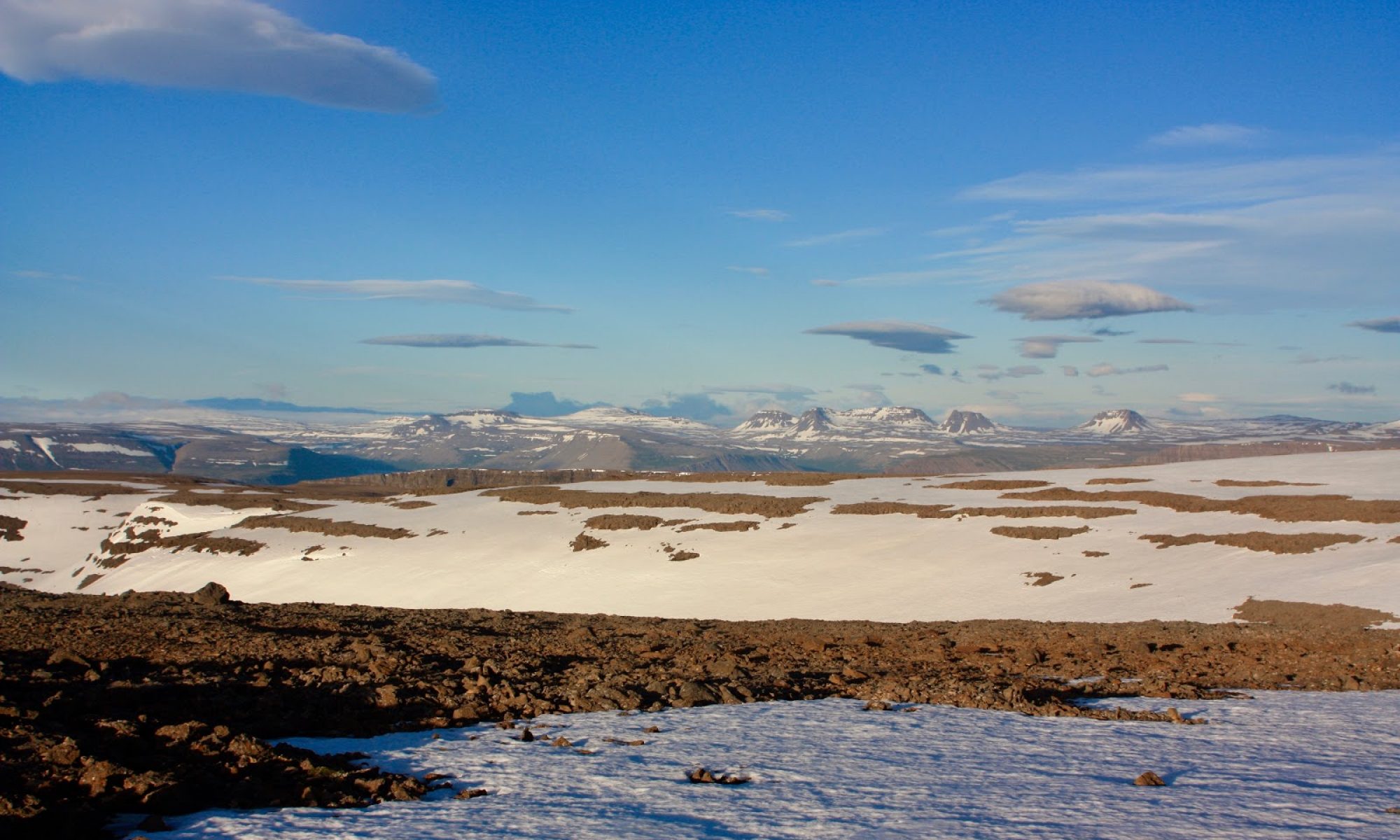
The word itself sounds cool. Say it: Pocket.
It can mean a lot of things, both as a noun and as a verb. It’s derived from the Anglo-French word pokete, which means, essentially, pouch.
The first thing that occurs to me is this: cargo shorts. I am not in favor of non-functional pockets. I want what I place in the pocket to remain there. I have experienced much trouble when car keys, wallet, or other crucial items, were not securely in the pocket.
The word has a satisfying punch to it, a good combination of consonants. It reminds me of a few things, including softball. I haven’t played softball in about thirty years, but I used to play on a church team. I was not a great player, but occasionally I made a good play.
My position was third base. One of the features of third base is that you tend to get line drives that come straight at your head. If you are paying attention you might catch them. If not, they might catch you.
There is a visceral sensation of pleasure when the ball meets your glove right in the pocket. It feels just the way it sounds. It makes your whole hand tingle.
And then there is billiards. The satisfying smack of the cue ball hitting the 8-ball, and the 8-ball plunking, decisively, into the corner pocket, just as you predicted it would.
A band’s rhythm section is said to be playing in the pocket when the drummer and bassist have not only good skills and a superb feel for the music, but great rapport with each other.
David St. Hubbins, of Spinal Tap, famously said “Jazz is mistakes.” Be that as it may, a rhythm section that is in the pocket can transform the interesting choices of a flamboyant soloist into something that seemed on purpose.
It’s all possible because of the security provided by a rhythm section that lays down a solid groove and keeps the music moving relentlessly and joyfully forward—past all dreadful and brilliant mistakes.
If you are one of those show-off guitarists or free-spirit vocalists, (or, God forbid, a saxophonist), a rhythm section that is playing in the pocket gives you permission to fly without worrying too much about your landing.
It allows you to be simultaneously inspired and sloppy, to slip out of time like a shaman on mushrooms and then glide back in, without fuss, to be welcomed by that reliable drummer and bassist who may shake their heads at you, but will welcome you home.
Here’s an illustration from the world of sports:
Sprinting is usually considered an individual activity, the forte of those who want neither to depend on anyone, nor anyone to depend on them. That is probably why I felt inclined toward sprinting in my own athletic pursuits. But in a 400-meter relay, the smooth transition of the baton from one runner’s hand to another is a magical and satisfying demonstration of being in the pocket with another person.
On the track, there is a 20-meter zone in which the passing of the baton must occur. The task is to pass the baton from one runner to the other while both runners are going as fast as is possible within the limitations imposed by physics. Obviously, one runner must be decelerating while the other is accelerating. They must not step out of the lane, of course. Neither is running at full speed, but the goal is to come as close to this ideal as possible.
Twenty meters goes by quickly when you are sprinting. A lot can go wrong. Bodies can bump. Feet can get tangled. You can just plain miss. It is hard for the one receiving the baton to trust a runner she can’t see—and she must not look. The handoff must happen within the zone. Timing must be spot-on. Many things matter: proper hand position, decisive placement of the baton, a fluid transition from restraint to explosiveness.
The following video is instructive. I could have chosen many videos to illustrate the concept, but since Shelley-Ann Fraser-Pryce—the red-haired goddess on the Jamaican team—is my favorite female sprinter of all time, I chose this one. Watch the women in yellow. My goodness, a well-executed handoff looks so effortless!
The Chinese sprinters in this video are disastrously not in the pocket. It goes from bad to worse. It’s a mistake to ascribe this nightmare handoff to incompetence; no one gets to the world-championships without being competent. Maybe these two sprinters were put together for their speed, but they just didn’t know each other well enough. Hadn’t put in enough time together.
It’s hard to say, exactly, why things go so wrong. But in such a short space of time, there are multiple moments of what Cool Hand Luke described as a failure to communicate. These failures compound. The Jamaican sprinters, in contrast, are “poetry in motion,” as the saying goes. They make what is not easy look so easy.
https://www.youtube.com/watch?v=AV8GNQTOyBU
Reliability, security, solidity, timing, and trust. Here’s another sports illustration:
In rock climbing, there can be an attentiveness that is rare and remarkable between two people who have formed an abiding and reliable partnership. Taking turns as they do between belaying and being on “the sharp end” of the rope, both partners are well-acquainted with the weight of responsibility, and the thrill (or dread) of vulnerability.
What can happen after time—because it takes time—is the birth of an extraordinary trust. This trust is expressed in the clipped and understated phrase watch me. Implicit in the phrase: Catch me.
Here’s a video of Tommy Caldwell climbing a pitch on the Dawn Wall of El Capitan. As you watch it, think of the guy who you never see in the clip: the belayer.
You hear him say “C’mon Tommy!” with no discernable distress in his voice. Imagine the trust required. It isn’t just the trust a climber must have in a belayer; it is also the trust a belayer must have in himself.
This trust frees the climber to pay, as we say, undivided attention. There is no room for the thought what if he doesn’t catch me.
I have shared video of the world’s fastest woman, and a man who is perhaps the greatest climber in the world despite the loss of his index finger to an accident with a table saw. By doing this, I run the risk of implying that to be in the pocket means to possess extravagant gifts, or to push yourself toward something called mastery.
That is not my intent. So, let me be clear, at least regarding my own place in the world: There is not a single art, sport, or skill in which I have achieved even mid-level competency, much less mastery.
In addition, I have routinely made the case in my essays that greatness is an overrated concept.
I’m not sure why I chose these particular videos. Probably just because I like to watch them. I find them both to be stunning—and hugely different—examples of the beauty of human movement. But though they demonstrate great accomplishment, they speak as well to a quality of relationship between people.
In both cases, they show how a symbiotic and mutually beneficial relationship is a key factor in the action. The drummer and bassist show it too. As the late and great Dr. John might remind us, to be in the pocket with someone means to be in the right place at the right time with the right companion. These three things do not often line up.
Prepositions matter. To be in the pocket with someone is not the same as to be in the pocket of someone. In both cases, the word pocket retains an association with security, but the phrases veer into drastically different territory.
When, like that bassist and drummer, you are with someone in the pocket, security comes from within yourself, from a confidence in your own solid presence in the world. This confidence meets the confidence of another, and enhances the collaboration.
The space in which this happens is the pocket. The pouch.
But when you are in the pocket of someone, your security comes from that person’s power, and is revocable at that person’s whim. The price you pay to is to have your own power swallowed up in their pocket. They have you in the bag.
It happens when there is a power imbalance, an unhealthy need for approval, an opportunity for blackmail, or the likelihood of retribution. It is common in business, in the Senate, in middle school, in graduate school, in romance, in religion, in organized crime, and in banking.
On the other hand, it is an elusive and beautiful thing to be in the pocket with another person. Secure in the mutual trust, you are free to be both daring and capable.
My Facebook profile tells me I have 333 friends. As a measure of anything meaningful, this is a useless assertion. I don’t know what an accurate number is, but maybe no more than 20. And of those, the friends with whom I’ve felt in the pocket—even for a fleeting moment—could be counted on my ten fingers, maybe with some fingers to spare.
It’s hard to know, exactly, what makes it work. It doesn’t happen just because you might want it to.
While agreement in regard to all the particulars of life does not seem necessary, maybe some sort of common notion regarding what is valuable is necessary. Some sort of alignment of the spirit. If it happens, treasure it.
Despite my occasional affability, I am a person who tends to be ill-at-ease in the world of social interaction, and my greatest peace is in nature. I have not often felt in the pocket with another person.
I have more often felt it in nature. I’ve felt myself secure in the pocket of the earth, so to speak. So, I want to share a few of my favorite natural pockets, and maybe convey a bit of the joy, satisfaction, and peace I feel when I am in them.
When I think of pockets in nature, I think of hot springs, harbors, places of emergence, places to build a cabin or grow a garden, a place to moor the boat, shelter the goats. I think of a cove that offers respite along a rugged coast, or a meadow that opens up in a tangled forest.
One of my favorite natural pockets is an especially elegant alpine landform called a cirque. It occurs in mountain ranges that have been sculpted by glaciers. A cirque is a bowl-shaped basin ringed by steep cliffs, and it often cradles a lake which may be bermed by rubbly moraines of gravel left behind by retreating ice.
A chain of such small lakes may occur in tiers, one below the other, linked by a silver ribbon of cascading water. Each lake represents a stage in the glacial story. These are called pater noster lakes, which is a marvelous name alluding to their similarity to rosary beads on a string.
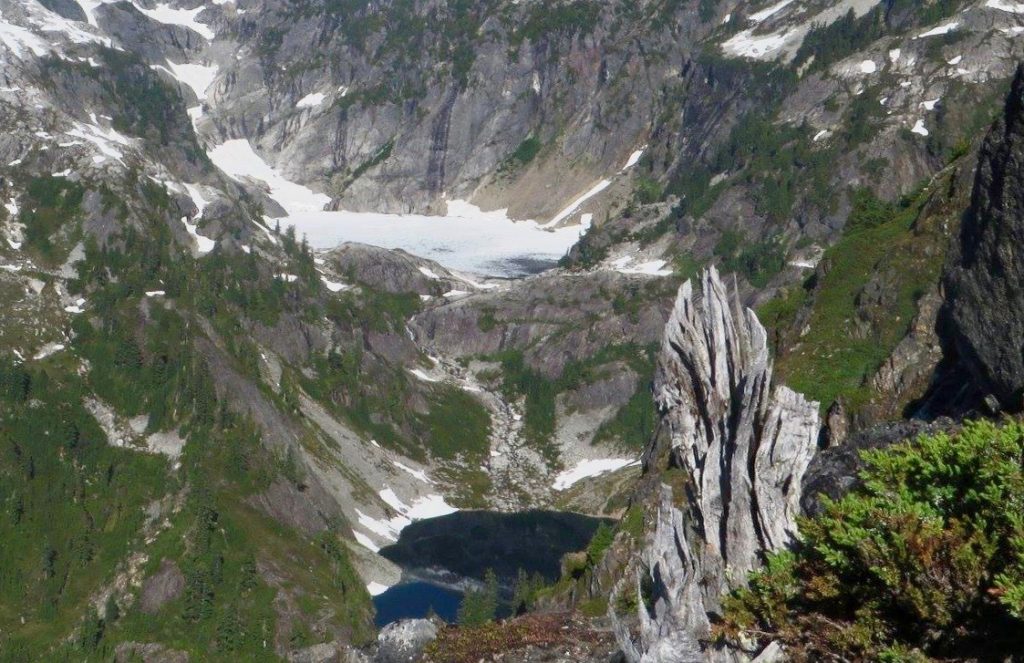
In the highest cirques, rather than a lake, you can often find a charming bit of ice called a pocket glacier. It’s a small glacier that is nestled into the pocket of the mountain, sort of like a white mouse in the pocket of a waistcoat.
The most glorious campsites in the North Cascades, the ones that I love to return to, are in such basins. A gentle place by the water’s edge, a place to set up camp after coming down from the exhilaration of a windy summit or a knife-edged ridge.
There is a quiet and deep satisfaction at coming to rest in the center of a basin ringed by peaks. Find a patch of soft ground, near a stream… fill up your water bottles, fire up the stove, and make some coffee. Snug and secure in the pocket.
There is something about a pocket that seems nurturing and life-giving. Womb-like, of course. Maternal. And it is also powerful. There is a center of gravity in a pocket. Maybe a pocket is the root chakra of landforms. It’s where every creature comes to drink.
In Central Washington, just a couple of hours from the alpine cirques of the North Cascades, there is an entirely different sort of pocket, although it also holds water. This region in the rain shadow of the Cascades is one of the driest parts of North America.
In this desert, there is a weird and wonderful landscape called the Channeled Scablands. It is characterized by deep gashes that cut through layers of basalt, as if a giant bear from outer space had made a swipe at the earth. Scattered through the coulees and among the outcrops of basalt are hundreds of small lakes called potholes.
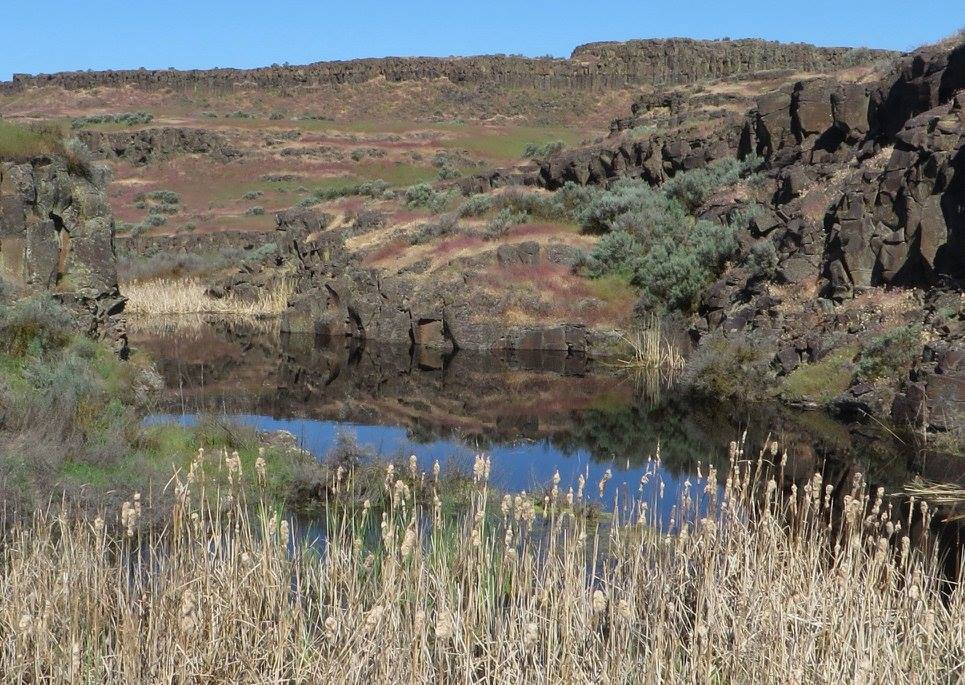
The “channels” of the Channeled Scablands are the result of unimaginably huge floods that ripped through this country, repeatedly, about 15,000 years ago. The floods scoured the land, leaving behind thousands of pockets in the basalt. In time, the pockets filled with water. And now this dry, dry desert is prime habitat for countless migrating waterbirds.
Water and pockets just seem to go together.
And one wonderful place where they go together is on the eastern flank of the Sierra Nevada, in California, where there is a place called Long Valley, which is known for its numerous hot springs.
Long Valley is, in fact, an ancient caldera, which is in itself a kind of pocket left behind by an enormous volcanic eruption. Underneath this broad, grassy valley, the earth’s heat still simmers. Hot water percolates to the surface, and it finds its way into little pools.
The pool may be entirely natural, or it may be augmented with a little bit of human labor to hold the water in its pocket. On a frosty mountain morning, the way to find the hot springs is to look for the steam and navigate the network of dirt roads until you find the pool of your choice.
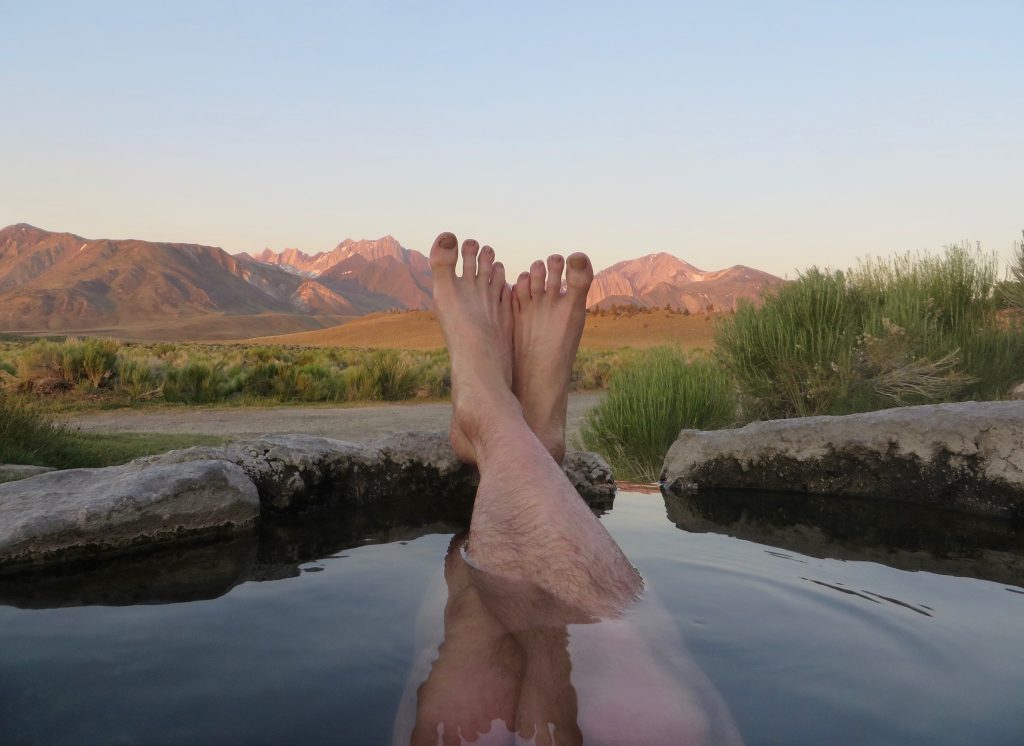
There is one pool that is a personal favorite of mine. I’ve been lucky enough to have it all to myself as the sun casts its rosy first light on Mount Morrisson.
And I will end with this, which is an exercise in looking forward rather than looking backward. I haven’t been to this place yet, so can offer no photos. But here’s a screenshot from Google maps, to give a rough approximation of the shape of the land, seen from a great height:
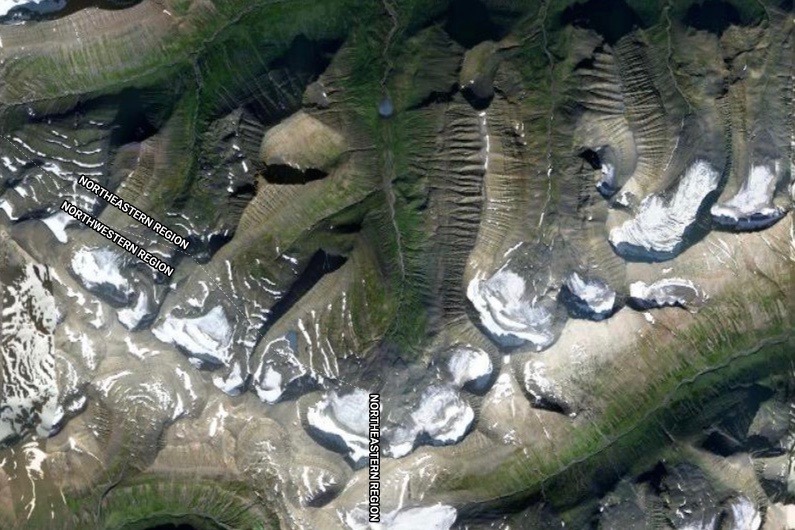
In the north of Iceland, smack-dab in the middle of a mountainous peninsula called Trollstagi (the Troll Peninsula), there is a long, rugged crest of connected peaks running east to west. The broad sweep of it is graceful, reminiscent of a bird’s wings.
The crest of the ridge is sharp and punctuated by horns, which are not trombones, but are pointy pyramidical peaks common in glacial landscapes. Stretching to the north of this long crest, like feathers trailing from the wing of the bird, subsidiary parallel ridges stretch out for a couple of kilometers.
It is patterned landscape. The parallel ridges that come off of the main ridge are all fluted by countless ribs of shattered basalt, with gullies between them. I know I’m mixing my animal metaphors because I described the ridges as feathers, but the ribs remind me of fish bones.
Between each ridge, a long and mostly straight glacial valley aims for the main ridge. And each valley ends in at least one cirque that holds a pocket glacier. Some valleys hold a few small glaciers, like lobes on a cauliflower. In a 15-mile span from east to west, there are no less than a dozen cirques holding pocket glaciers. Each one represents its own journey, and is approached through its own private valley.
Beautiful little cirques, holding beautiful little glaciers. Did I say holding? I did. That is a curious thing. In a landscape that is severe, it is interesting that the verbs that occur to me to describe the relationship between these glaciers and the mountain itself are gentle, almost nurturing. They are cradled. Nestled. Snuggled up to the ridge.
I have not been to this place, but I have studied it obsessively—so much so that I have decided this: On my next trip to Iceland, whenever that may be, I hope to spend multiple days exploring this ridge, while based out of a modest lodge that is perfectly situated to this purpose. I might also bring a tent, to camp in these cirques—but weather in Iceland, at altitude, can be notoriously awful, so the lodge is a good back-up plan.
It may be the best place in all of Iceland from which to pursue the particular odd obsession of pocket glacier tourism—which is not really a thing, but perhaps I have just invented it.
After all, we must all find our own way to be in the pocket.
